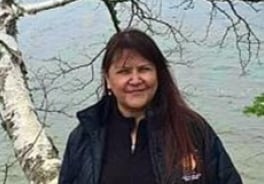Representatives of Ornge, Ontario’s air ambulance operation, told a coroner’s inquest that it is still impossible to meet Ministry of Health deadlines for transporting critical patients in the north, although response times have improved since 2021.
Chief Operating Officer Wade Durham and Chief Medical Officer Dr. Bruce Sawadsky testified at hearings into the deaths of five members of the Constance Lake First Nation during an outbreak of blastomycosis, a fungal lung disease, in 2021.
Luke Moore, 43, and Lizzie Sutherland, 56, died at Hearst’s Notre Dame Hospital while awaiting flights to better-equipped hospitals. The cause of his death was blastomycosis.
Sawadsky explained that the most critical patients, described as having life- or limb-threatening conditions, must be picked up and taken to their destination within four hours and cannot be denied care, according to provincial policy.
However, he said even with Ornge’s best efforts, that’s impossible in northern Ontario because of the vast distances.
Sawadsky said that actually, in 2021, at the time of the outbreak, the time to get an air ambulance to a critically ill patient up north, to a city like Hearst, was five hours, but it has since improved to just under four. in most cases.
That doesn’t include, he said, the time needed to get the patient to their destination and receive higher levels of care.
However, weather conditions can also wreak havoc on patient access, as witnesses in Moore’s case described.
Late in the afternoon on November 18, 2021, doctors said Moore was critically ill at Hearst Hospital and needed the quickest response Ornge could muster to airlift him to Health Sciences North (HSN) in Sudbury.
However, it didn’t take long for the plane’s pilot at the nearest base in Timmins to say that landing at Hearst Airport was not possible. The reasons given were snow on the runway, strong crosswinds and lack of deicing equipment at the airport.
Durham said that even if the runway had been clear and de-icing equipment was available, crosswinds would have prevented the plane from landing.
Additionally, in Sudbury a helicopter was unable to fly due to poor visibility and helicopters generally do not fly through clouds in winter because they accumulate ice.
Ornge says many factors prevented the plane from landing
Durham said another weather check around 8:40 p.m. found the same conditions at Hearst and the pilots declined the transfer.
Around midnight, pilots on a plane at the Thunder Bay base also said conditions had not changed.
The track was still slippery and the crosswinds were strong.
Sawadsky said the idea of transporting Moore by ambulance to Kapuskasing, where crosswinds were a minor factor at the airport and there was some de-icing equipment, was scrapped as too risky because Moore was seriously ill and there was no guarantee the plane would be able to take off in the weather.
Weather conditions improved the next morning and Durham said the pilots had a report on runway conditions but expected to hear the snow would be gone by 10 a.m.
Moore died around 9 a.m. on Nov. 19 while Ornge waited for someone to confirm that snow clearing had been completed.
He noted that limitations such as single runways, lack of de-icing equipment and lack of runway clearing standards are not uncommon at other northern Ontario airports.
Later that day, Sawadsky said the process was much easier for Lorraine Shaganash.
She was designated with the highest level of critical illness around 5:10 p.m. and the pilots were in the air five minutes later.
In just under six hours, I was on HSN in Sudbury.
Sawdsky said it would have been faster if the response plane had been in Timmins instead of the Thunder Bay base.
Unfortunately, Shaganash died the next day on November 20.
That afternoon, Sutherland was at Hearst Hospital.

Doctors said she probably had blastomycosis and although she was very ill, she was quite stable but needed advanced care, so HSN was contacted for a bed.
“She was at risk, but not necessarily high risk,” Sawadsky said.
Because Ornge typically has more service requests than planes, it has to put patients on a list, Sawadsky said.
Sutherland came third out of three.
Sawadsky said they were also having difficulty staffing planes due to COVID-19 and there were only about three planes instead of the five that normally would have been available.
Later that afternoon, Sutherland was ranked second among two patients who needed transfers.
If all the planes had been in the air at the time, she would have been transported, he said.
Sutherland was then trapped at Hearst when HSN said someone else had occupied her bed.
He said there seemed to be a communication problem between hospitals about the availability of HSN beds, but it is not something Ornge is involved in.
Finally, that same night, with a bed again available, Sutherland was now further down the waiting list, one-fourth of every four patients needing transportation.
One nurse who already testified said she was concerned that Sutherland did not appear to be a priority.
Doctor says some misunderstand use of word ‘priority’
However, Sawadsky said doctors used the word “priority” clinically, to put patients in order, but that everyone was important.
With the window to transport Sutherland closed overnight, her condition suddenly worsened, and when a plane became available in the morning, she was declared palliative and unlikely to survive the journey.
Durham said he and others went to Hearst on Dec. 13 to meet with hospital and airport representatives, the community and paramedics to hear their concerns.
He said he heard a lot of frustration and admitted there was room for improvement, especially in communication.
Since the outbreak, Sawadsky said, there has been study on how to improve response times in the north, noting that at the time there were three aircraft serving northwestern Ontario, but only one in the northeast.
“There shouldn’t be a different standard,” he said.
Since then, he said, the first of two aircraft has been added to Ornge’s base in Sudbury, and the second will be operational in July of next year.
Additionally, he said, a plane has been ordered that will be based at Lake Simcoe.
That plane, Sawadsky said, will travel faster, reduce transport times and be able to transport two critical patients instead of one.
That plane, he said, should be in use by mid-2028.
Additionally, 80 more paramedics They have been hired in recent months, he added.
Durham said more assets would be helpful for Ornge, but the next project is to renew its helicopter fleet, which would take about 10 years.
As for airport facilities in northern Ontario, Durham said it would be helpful to have someone on duty at all times to clear runways and provide reports.
“The area does not have the necessary services,” says the medical director
Additionally, Durham said, there is a list of minimum standards for northern airports, but he welcomed the suggestion that the jury could make a list of improvements to make transportation safer and easier.
He noted that Hearst Airport has since introduced de-icing equipment and has also purchased equipment to keep planes ice-free while on the runway to ensure there is time to transfer patients before taking off again.
Under questioning by Constance Lake First Nation lawyer Bianca Braganza, Sawadsky said he is aware that as a health care organization funded entirely by the Ministry of Health, it has an obligation to First Nations patients.
she said 78 per cent of Ontario’s First Nations communities are located in northern Ontario.and reminded witnesses of the Truth and Reconciliation Commission’s calls to action on health care.
“I agree that the area is underserved and we are trying to correct that with the resources we have,” he said.
“We are presenting the arguments [to the Ministry of Health] “We need resources to serve indigenous communities, and the ministry has supported us a lot,” he said, referring to the purchase of new planes and the hiring of new personnel.
The investigation, which began in mid-October, continues.








